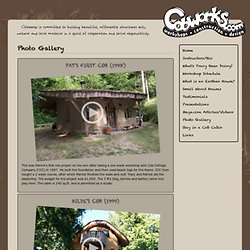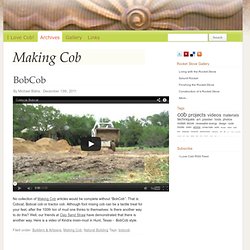

Une maison en pisé pour 200 euros. Un ancien professeur d’art, depuis peu à la retraite, a réalisé l’exploit de construire de ses propres mains, avec un budget de seulement 200 euros, une jolie petite maison de fermier dans la campagne anglaise.

Michael Buck sait définitivement se servir de ses deux mains. Tout a commencé lorsque ce jeune retraité anglais de 59 ans a réalisé au dos d’une enveloppe le croquis d’une petite maison de fermier. Puis il a ensuite fallu trouver des matériaux gratuits pour que ce croquis devienne réalité, l’apprenti architecte ayant décidé de ne pas débourser un sou de sa poche. Le choix du pisé, procédé de construction de murs en terre crue, s’est avéré évident. Le reste des matériaux a été récupéré : le sol provient d’un bateau abandonné de l’un de ses voisins et les fenêtres d’un vieux camion, pour ne citer qu’eux. Il a simplement dû faire appel à son portefeuille lorsqu’il est arrivé à cours de paille et de clous… Pour la modique somme de 200 €.
A Low Impact Woodland Home. From brick and mortar shops to city planning, we cover sustainable trends in construction, renovation, and more. Green Design Published on December 1st, 2008 | by Susan Kraemer Cash, that most basic element of our economy, can be in abysmally short supply for new young families scraping by on marginal jobs.

Sustainable housebuilding may not be foremost in their minds. But one young couple in Wales managing on an annual income of just $10,000 went ahead and built their own cheap home anyway, sustainably, mostly out of materials from “a rubbish pile somewhere.” They had wanted to spend as much time as possible at home while their two children were young. So they enlisted some help from family, and sometimes just from people passing by, and from any of their friends who stopped by to visit: The result was their very low impact homemade house. Four months of hard work and they were all 4 moved in and cozy. Total expenditure? “My experience is only having a go at one similar house 2yrs before and a bit of mucking around in-between. Sustainable design and construction: Want to try making one too? Cob Houses - Live Debt Free with Sustainable Development. Photo Gallery. Pat's First Cob (1998) This was Patrick's first cob project on his own after taking a one week workshop with Cob Cottage Company (CCC) in 1997.

He built the foundation and then used beach logs for the frame. CCC then taught a 2 week course, after which Patrick finished the walls and roof. Tracy and Patrick did the plastering. The budget for the project was $1,000. Hilde's Cob (1999) The major construction of this cob was completed in the summer of 1999. Garden Cob (2002) Elke and Patrick built the Garden Cob during an 8 week apprenticeship course. Christina's Cob (2002-2004) There are 3 separate cob projects on this site.
Kate's Cob (2003) Kate's cob is our largest cob house project to date. Deaconvale Farm Cob (2005) Tracy and Patrick were the instructors for this intensive 9 week, 9 person apprenticeship program. Lee's Courtyard (2000-2001) This courtyard was 2 separate workshops over 2 summers. Charles' Cob (2001) Charles wanted to use only materials from his site. I Love Cob! ∞ Making Cob. BobCob No collection of Making Cob articles would be complete without “BobCob”.

That is: Cobcat, Bobcat cob or tractor cob. Although foot mixing cob can be a tactile treat for your feet, after the 100th ton of mud one thinks to themselves: Is there another way to do this? Well, our friends at Clay Sand Straw have demonstrated that there is another way. Here is a video of Kindra mixin-mud in Hunt, Texas - BobCob style. Making Cob with a Auger Mixer? I’m fascinated by new ways of making cob. The magic to it is the vertical auger. We started with the big, blue Patz vertical Auger mixer.
Then we bought and modified a little orange mixer hopper meant for spray-able, fibrous mixes. With those two, we decided we needed something of an in between size that could be more portable than the big one, but make enough cob to be useful on a job site. Then we have a gravel screener to get the rocks out of the sand and the clay (somewhat). We’d love to have some help documenting “commercial” cob.